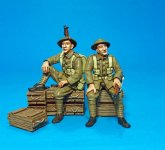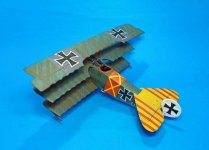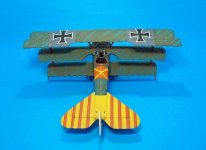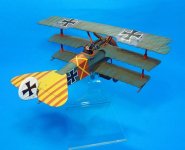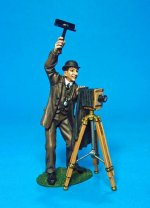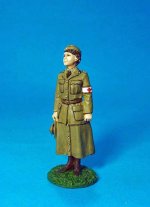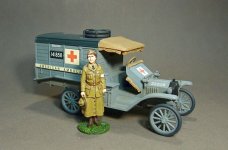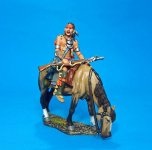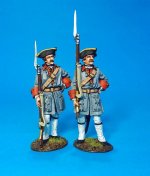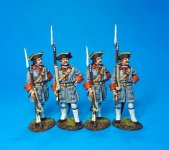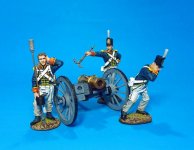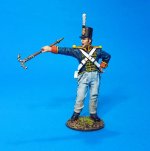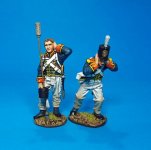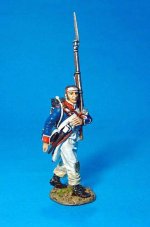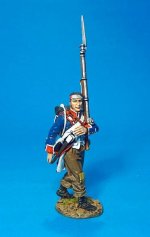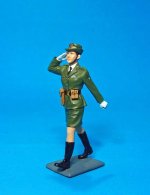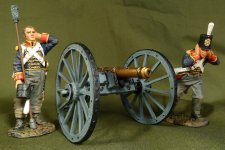Good Morning and welcome to the December releases written on a bright sunny day here in the San Francisco Bay Area, well it will be bright once the sun comes up. Here your Christmas present wishes come true.
A fantastic set of releases, many long awaited, included a Knights of the Sky releases, British Tommies, set that can be used with Ticonderoga, and my favorite a mounted woodland Indian.
Please note this is a 2 part announcement, so please see both parts.
As always hope you enjoy these as much as I do.
Best regards
Mike
Sierra Toy Soldier Company
THE GREAT WAR 1914-1918
The 58th (2/1st London) Division was an infantry division of the British Army, which was active in World War I.
In late August 1914 the War Office issued instructions for all formations of the Territorial Force to form reserve units. The men who had agreed to serve overseas were separated from the rest. Those left as 'home service only' were formed into 'second line' units, to create this reserve. In the London area, the 1st London Division became the first-line formation, while the second-line formation was given the designation 2/1st London Division. When many of the 'first line' units of the senior 56th (1st London) Division were sent overseas, that Division was temporarily disbanded and the rest of its units joined the 'second line' in the 2/1st London Division. In August 1915, the number 58 was allocated to the 2/1st London Division.
The Division arrived in France in July 1917, and took part in many of the major battles, including
The Battle of Bullecourt 1917, The Second Battle of Passchendaele 1917, The Somme 1918, and Battle of Amiens 1918.
They were to serve in France and Flanders until the Armistice, when it was disbanded.
GWB-20 BATTLE OF AMIENS, 6th August 1918, 58th 2/1st LONDON DIVISION, 2 Tommies waiting,
(5pcs)
Retail us$78
During WW2 the 58th Division was recreated, as an imaginary 'deception' formation.
The division was 'reformed' as a 'phantom division' created as part of 'Operation Fortitude North' as a replacement for the British 3rd Infantry Division which was going south to take part in a D-Day rehearsal. Unlike other 'phantom divisions' the 58ths number was chosen on the basis of Ultra reports that showed the Germans believed a 58th Infantry Division existed in the vicinity of Windsor.
KNIGHTS OF THE SKIES
Fokker DR1, 564/17 was flown by Ltn. Werner Steinhauser. He was attached to Jasta 11 in December 1917, and achieved 10 victories. On June 26th 1918 whilst flying a DVII, he was shot down and killed.
His early Fokker D1, 564/17 was marked with Steinhauser’s personal red and golden yellow colours, which were derived from his former regiment. The later 564/17 had the yellow cross on the red background reversed, to a red cross on a yellow background.
Otherwise the cowling and wheels were painted red as was normal for this Jasta. Steinhauser also had “eyes” painted around the cooling holes on the cowling.
ACE-21 Fokker DrI, 564/17, JASTA 11, Cappy, December 1917, Ltn. Werner Steinhauser,
(1pcs)
Retail us$208
**Please note stand and pilot figure not included**
World War one aviators were seen as more than soldiers, they were the Knights of the sky.The aces assumed important roles in strengthening public morale and bolstering support for the war effort. Their images sold war bonds, and they visited factories and schools. They were the subject of newspaper and magazine articles. Some published best-selling autobiographies, such as Baron Manfred von Richthofen’s The Red Battle Flier in 1917 and Oswald Boelke’s Hautpmann Boelckes Feldberichte published in 1916.
In no country was this public role more important than in Germany. Before the war, the government had worked hard to promote the zeppelin as the aerial weapon of the German people, successfully gaining massive public support. But as the war progressed, the airplane proved to be a more effective weapon, and the government needed to shift popular support away from the zeppelin. For this they used the aces, promoting them as modern knights—brave, daring, and chivalrous--who embodied all that was best about the German warrior. The nation’s highest military honour, the Pour le Merite, was given to aces. They dined with princes. Children collected trading cards with their images. When Oswald Boelke died, he was given a funeral worthy of royalty. The German public loved the aces and threw their support behind the airplane.
The Aces were the film stars of their day, and were constantly photographed and promoted.
ACEPIC - THE PHOTOGAPHER,
(2pcs)
Retail us$52
The Motor Corps were womens first opportunity to serve in the US Armed Forces in a position other than nursing. These women from the motor corps were to serve as drivers of Ambulances and other vehicles both in America and abroad.
BGC-04A - Womens Motor Corps of America 1916-1918 - Ambulance Driver,
(1pc)
Retail us$37
THE RAID ON ST. FRANCIS
The use of horses was not as common among the woodland Indians, as it was on the Great Plains, but it was an often used mode of transportation, which became more popular in the later years of the eighteenth century. The Shawnee tribe in the Ohio Country were known for using horses, with many references to large parties of native warriors traveling throughout the upper Ohio valley mounted on horses.
The horse also enabled the eastern natives to become less nomadic, as using horses as beasts of burden, the Indians of the Eastern Woodlands could travel further afield for trading, hunting and to gather sustenance. This allowed native communities to remain in one place longer.
RSF-20 - Mounted Woodland Indian,
(2pcs)
Retail us$88
THE BATTLE OF THE PLAINS OF ABRAHAM 1759
The Regiment de Bearne saw much action under Montcalm, and was present at all major engagements of the war.
Although no longer used for their original function, grenadier companies were still part of French infantry battalions. They were still regarded as the “shock troops” who were hand picked from the biggest and strongest recruits.
At Ticonderoga, Montcalm detached the grenadiers and held them as a reserve behind the main defensive line.
There were only minor differences between the line infantry and the grenadiers. Apart from the use of a broad tipped curved sabre in place of the usual straight sword, the Grenadiers were encouraged to wear moustaches, whilst other soldiers had to be clean shaven.
**Please Note these figures will also be available with bearskin hats, at a later date**
QF-38 - REGIMENT de BEARN, GRENADIERS WAITING IN RESERVE,
(2pcs)
Retail us$78
QF-38N - REGIMENT de BEARN, GRENADIERS WAITING IN RESERVE, SET#1
(4pcs)
Retail us$138
THE PENINSULAR WAR 1807-1814
The British artillery of the Napoleonic Wars was well trained, efficient and motivated. Ther officers were very much educated professionals. They did not, could not, buy their commissions or promotions. However, the effects of all this excellent training and schooling was often negated by the small size of the artillery corps and the fact that promotion was by seniority rather than by merit.
For campaign the gunners wore loose white or grey trousers. Originally they were worn over the breeches and gaiters. Later they were worn in their own right as trousers and the buttoned side fly was abandoned.
PBART-01 - BRITISH FOOT ARTILLERY Pre-1813, ARTILLERY CREW FIRING,
(3pcs)
Retail us$117
**Please note set does not include gun**
The following guns will be suitable
BCHGUN-01
BCHGUN-02
BCHGUN-03
PBART-02 - BRITISH FOOT ARTILLERY Pre-1813, ARTILLERY CREW FIRING,
(1pc)
Retail us$42
PBART-03 BRITISH FOOT ARTILLERY Pre-1813, ARTILLERY CREW WITH HANDS ON EARS,
(2pcs)
Retail us$78
Advancing and action poses for the French line will be available in 2014.
There will be one more set of line infantry marching, in a similar marching pose, but it will not have patches on the trousers.
PFL-08W FRENCH LINE INFANTRY 1807, 66th Line, 4th Company, WOUNDED FUSILIER MARCHING, White Trousers,
(1pc)
Retail us$40
PFL-08B - FRENCH LINE INFANTRY 1807, 66th Line, 4th Company, WOUNDED FUSILIER MARCHING, Brown Trousers,
(1pc)
Retail us$40
PFL-08D - FRENCH LINE INFANTRY 1807, 66th Line, 4th Company, WOUNDED FUSILIERS MARCHING
(2pcs)
Retail us$76
Now on to Part 2.
Mike
Sierra Toy Soldier Company
A fantastic set of releases, many long awaited, included a Knights of the Sky releases, British Tommies, set that can be used with Ticonderoga, and my favorite a mounted woodland Indian.
Please note this is a 2 part announcement, so please see both parts.
As always hope you enjoy these as much as I do.
Best regards
Mike
Sierra Toy Soldier Company
THE GREAT WAR 1914-1918
The 58th (2/1st London) Division was an infantry division of the British Army, which was active in World War I.
In late August 1914 the War Office issued instructions for all formations of the Territorial Force to form reserve units. The men who had agreed to serve overseas were separated from the rest. Those left as 'home service only' were formed into 'second line' units, to create this reserve. In the London area, the 1st London Division became the first-line formation, while the second-line formation was given the designation 2/1st London Division. When many of the 'first line' units of the senior 56th (1st London) Division were sent overseas, that Division was temporarily disbanded and the rest of its units joined the 'second line' in the 2/1st London Division. In August 1915, the number 58 was allocated to the 2/1st London Division.
The Division arrived in France in July 1917, and took part in many of the major battles, including
The Battle of Bullecourt 1917, The Second Battle of Passchendaele 1917, The Somme 1918, and Battle of Amiens 1918.
They were to serve in France and Flanders until the Armistice, when it was disbanded.
GWB-20 BATTLE OF AMIENS, 6th August 1918, 58th 2/1st LONDON DIVISION, 2 Tommies waiting,
(5pcs)
Retail us$78
During WW2 the 58th Division was recreated, as an imaginary 'deception' formation.
The division was 'reformed' as a 'phantom division' created as part of 'Operation Fortitude North' as a replacement for the British 3rd Infantry Division which was going south to take part in a D-Day rehearsal. Unlike other 'phantom divisions' the 58ths number was chosen on the basis of Ultra reports that showed the Germans believed a 58th Infantry Division existed in the vicinity of Windsor.
KNIGHTS OF THE SKIES
Fokker DR1, 564/17 was flown by Ltn. Werner Steinhauser. He was attached to Jasta 11 in December 1917, and achieved 10 victories. On June 26th 1918 whilst flying a DVII, he was shot down and killed.
His early Fokker D1, 564/17 was marked with Steinhauser’s personal red and golden yellow colours, which were derived from his former regiment. The later 564/17 had the yellow cross on the red background reversed, to a red cross on a yellow background.
Otherwise the cowling and wheels were painted red as was normal for this Jasta. Steinhauser also had “eyes” painted around the cooling holes on the cowling.
ACE-21 Fokker DrI, 564/17, JASTA 11, Cappy, December 1917, Ltn. Werner Steinhauser,
(1pcs)
Retail us$208
**Please note stand and pilot figure not included**
World War one aviators were seen as more than soldiers, they were the Knights of the sky.The aces assumed important roles in strengthening public morale and bolstering support for the war effort. Their images sold war bonds, and they visited factories and schools. They were the subject of newspaper and magazine articles. Some published best-selling autobiographies, such as Baron Manfred von Richthofen’s The Red Battle Flier in 1917 and Oswald Boelke’s Hautpmann Boelckes Feldberichte published in 1916.
In no country was this public role more important than in Germany. Before the war, the government had worked hard to promote the zeppelin as the aerial weapon of the German people, successfully gaining massive public support. But as the war progressed, the airplane proved to be a more effective weapon, and the government needed to shift popular support away from the zeppelin. For this they used the aces, promoting them as modern knights—brave, daring, and chivalrous--who embodied all that was best about the German warrior. The nation’s highest military honour, the Pour le Merite, was given to aces. They dined with princes. Children collected trading cards with their images. When Oswald Boelke died, he was given a funeral worthy of royalty. The German public loved the aces and threw their support behind the airplane.
The Aces were the film stars of their day, and were constantly photographed and promoted.
ACEPIC - THE PHOTOGAPHER,
(2pcs)
Retail us$52
The Motor Corps were womens first opportunity to serve in the US Armed Forces in a position other than nursing. These women from the motor corps were to serve as drivers of Ambulances and other vehicles both in America and abroad.
BGC-04A - Womens Motor Corps of America 1916-1918 - Ambulance Driver,
(1pc)
Retail us$37
THE RAID ON ST. FRANCIS
The use of horses was not as common among the woodland Indians, as it was on the Great Plains, but it was an often used mode of transportation, which became more popular in the later years of the eighteenth century. The Shawnee tribe in the Ohio Country were known for using horses, with many references to large parties of native warriors traveling throughout the upper Ohio valley mounted on horses.
The horse also enabled the eastern natives to become less nomadic, as using horses as beasts of burden, the Indians of the Eastern Woodlands could travel further afield for trading, hunting and to gather sustenance. This allowed native communities to remain in one place longer.
RSF-20 - Mounted Woodland Indian,
(2pcs)
Retail us$88
THE BATTLE OF THE PLAINS OF ABRAHAM 1759
The Regiment de Bearne saw much action under Montcalm, and was present at all major engagements of the war.
Although no longer used for their original function, grenadier companies were still part of French infantry battalions. They were still regarded as the “shock troops” who were hand picked from the biggest and strongest recruits.
At Ticonderoga, Montcalm detached the grenadiers and held them as a reserve behind the main defensive line.
There were only minor differences between the line infantry and the grenadiers. Apart from the use of a broad tipped curved sabre in place of the usual straight sword, the Grenadiers were encouraged to wear moustaches, whilst other soldiers had to be clean shaven.
**Please Note these figures will also be available with bearskin hats, at a later date**
QF-38 - REGIMENT de BEARN, GRENADIERS WAITING IN RESERVE,
(2pcs)
Retail us$78
QF-38N - REGIMENT de BEARN, GRENADIERS WAITING IN RESERVE, SET#1
(4pcs)
Retail us$138
THE PENINSULAR WAR 1807-1814
The British artillery of the Napoleonic Wars was well trained, efficient and motivated. Ther officers were very much educated professionals. They did not, could not, buy their commissions or promotions. However, the effects of all this excellent training and schooling was often negated by the small size of the artillery corps and the fact that promotion was by seniority rather than by merit.
For campaign the gunners wore loose white or grey trousers. Originally they were worn over the breeches and gaiters. Later they were worn in their own right as trousers and the buttoned side fly was abandoned.
PBART-01 - BRITISH FOOT ARTILLERY Pre-1813, ARTILLERY CREW FIRING,
(3pcs)
Retail us$117
**Please note set does not include gun**
The following guns will be suitable
BCHGUN-01
BCHGUN-02
BCHGUN-03
PBART-02 - BRITISH FOOT ARTILLERY Pre-1813, ARTILLERY CREW FIRING,
(1pc)
Retail us$42
PBART-03 BRITISH FOOT ARTILLERY Pre-1813, ARTILLERY CREW WITH HANDS ON EARS,
(2pcs)
Retail us$78
Advancing and action poses for the French line will be available in 2014.
There will be one more set of line infantry marching, in a similar marching pose, but it will not have patches on the trousers.
PFL-08W FRENCH LINE INFANTRY 1807, 66th Line, 4th Company, WOUNDED FUSILIER MARCHING, White Trousers,
(1pc)
Retail us$40
PFL-08B - FRENCH LINE INFANTRY 1807, 66th Line, 4th Company, WOUNDED FUSILIER MARCHING, Brown Trousers,
(1pc)
Retail us$40
PFL-08D - FRENCH LINE INFANTRY 1807, 66th Line, 4th Company, WOUNDED FUSILIERS MARCHING
(2pcs)
Retail us$76
Now on to Part 2.
Mike
Sierra Toy Soldier Company


